u1pa2-040b1.htm
from: Online Sanskrit Dictionary, February 12, 2003 . http://sanskritdocuments.org/dict/dictall.pdf 090907
Downloaded, set in HTML, and edited by U Kyaw Tun, M.S. (I.P.S.T., U.S.A.), and staff of TIL Computing and Language Centre, Yangon, Myanmar. Not for sale. No copyright. Free for everyone.
index.htm | Top
SED-vow-u1u2-indx.htm
•
उपात्त (upaatta)
Skt:
उपात्त (upaatta) - obtained - OnlineSktDict
•
उपाधिः (upaadhiH)
Skt:
उपाधिः (upaadhiH) - (f) title - OnlineSktDict
•
उपाय (upaaya)
Skt:
उपाय (upaaya) m. means -
OnlineSktDict
Pal: upāya m. means, expedient, way, stratagem -
UPMT-PED053
•
उपायतः (upaayataH)
Skt:
उपायतः (upaayataH) - by appropriate
means - OnlineSktDict
•
उपार्जन
(upaarjana)
Skt:
उपार्जन
(upaarjana) - earning/ acquiring - OnlineSktDict
•
उपालभते
(upaalabhate)
Skt:
उपालभते
(upaalabhate) - to reproach - OnlineSktDict
•
उपाश्रि
(upaashri)
Skt:
उपाश्रि
(upaashri) - to take shelter in - OnlineSktDict
•
उपाश्रिताः
(upaashritaaH)
Skt:
उपाश्रिताः
(upaashritaaH) - being fully situated - OnlineSktDict
•
उपाश्रित्य
(upaashritya)
Skt:
उपाश्रित्य
(upaashritya) - taking shelter of - OnlineSktDict
•
उपासते
(upaasate)
Skt:
उपासते
(upaasate) - worship - OnlineSktDict
•
उपाहारगृह
(upaahaaragRiha)
Skt:
उपाहारगृह
(upaahaaragRiha) - restaurant - OnlineSktDict
•
उपाहारगृहम्
(upaahaaragRiham.h)
Skt:
उपाहारगृहम्
(upaahaaragRiham.h) - (n) restaurant - OnlineSktDict
•
उपेतः (upetaH)
Skt:
उपेतः (upetaH) - having reached or attained - OnlineSktDict
•
उपेत्य
(upetya)
Skt:
उपेत्य
(upetya) - achieving - OnlineSktDict
•
उपेक्षा
(upekShaa)
Skt:
उपेक्षा
(upekShaa) - disregard - OnlineSktDict
Pal: upekkhā , upekhā f.
indifference, equanimity, neutrality - UPMT-PED053
UKT: With पै (pai), we come to face to Two-three-tone problem that exists between IE and Burmese language. The पै (pai) here is the "short tone" of IE, which is equal to the "modal register" of Burmese-Myanmar
{pè.} {pèý} {pè:}.
•
उपै (upai)
Skt:
उपै (upai) - to go to - OnlineSktDict
•
उपैति (upaiti)
Skt:
उपैति (upaiti) - gets - OnlineSktDict
•
उपैष्यति
(upaishhyasi)
Skt:
उपैष्यति
(upaishhyasi) - you will attain - OnlineSktDict
•
उप्कारः
(upkaaraH)
Skt:
उप्कारः
(upkaaraH) - (m) cess - OnlineSktDict
•
उभय (ubhaya)
Skt: उभय ubhaya
adj. of both kinds. pron. adj.
in both ways; belonging to both sides ; both
- SpkSkt
Pal: ubha , ubhaya adj. adj. both - UPMT-PED054
¤ उभया ubhayā
indecl. in both ways
¤ उभयत ubhayata
m. from both sides ; on both sides
¤ उभयत्र ubhayatra
indecl. in both sides; on both sides; in both cases
¤ उभयाक्ष ubhayākṣa
adj. binocular
¤ उभयाविन् ubhayāvin
adj. mutual
•
उभयत्र (ubhayatra)
Skt:
उभयत्र (ubhayatra) - at both places - OnlineSktDict
• उभयोः (ubhayoH)
Skt: उभयोः (ubhayoH) - both - OnlineSktDict
•
उभे
(ubhe)
Skt:
उभे
(ubhe) - both - OnlineSktDict
•
उभौ
(ubhau)
Skt:
उभौ
(ubhau) - both - OnlineSktDict
•
उमा
(umaa)
Skt: उमा
(umaa) - pArvatI - OnlineSktDict
Pal: umā f. radiance
- UPMT-PED054
See Parvati in my notes.
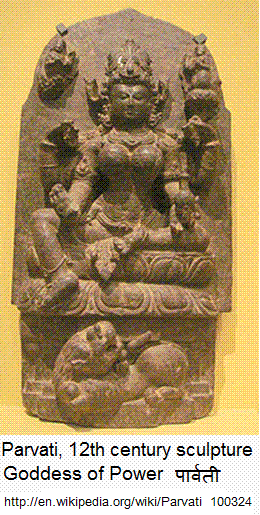
From Wikipedia: http://en.wikipedia.org/wiki/Parvati 100324
Parvati (Skt: पार्वती Pārvatī ; Malayalam: പാര്വതി Parvathy ; Malay: Parwati ; Thai: Nang Uma-Devi) is a Hindu goddess. Parvati is also regarded as a representation of Shakti, albeit the gentle aspect of that goddess because she is a mother goddess. Parvati is considered by some schools of Hinduism as the supreme Divine Mother or Lordess and all other goddesses are referred to as her incarnations or manifestations. Shaktas consider her as the ultimate Divine Shakti — the embodiment of the total energy of the universe.
Parvati is nominally the second consort of Shiva, the Hindu god of destruction and rejuvenation. However, she is not different from Satī, being the reincarnation of that former consort of Shiva. Parvati is the mother of the gods Ganesha and Skanda (Kartikeya). Some communities also believe her to be the sister of god Vishnu. She is also regarded as the daughter of the Himalayas.
Parvati when depicted alongside Shiva appears with two arms, but when alone,
she is shown having four arms, and astride a tiger or lion. Generally considered
a benign goddess, Parvati also has fearful aspects like Durga, Kali, Chandi (![]() {saN~ði}), and
the
Mahavidyas as well as benevolent forms like Mahagauri, Shailputri, and
Lalita.
{saN~ði}), and
the
Mahavidyas as well as benevolent forms like Mahagauri, Shailputri, and
Lalita.
UKT: Parvati (as Chandi) is included in the worship of the Nine-Gods
{Bu.ra: ko:hsu}

{pu-zau pwè:} or the gods of the nine planets Navagraha (Skt: नवग्रह ). See The Five Great Gods in The Nine-Gods Puja in the Folk Elements in Burmese Buddhism by Maung (Dr.) Htin Aung. M01-M4M-indx.htm, folk-indx.htm of this packet of CDs on MYANMAR - the land and its people."Then the Master sets up his last group of figures. They are five in number representing the Five Great Gods, namely:
1. Thurathati{thu-rath~tha.ti},
2. Sandi{saN~ði}, (not to be confused with
{san~da} the 'Moon')
3. Paramay-thwa{pa.ra.mé-thwa},
4. Maha-Peinne{ma.ha-pain~nè},
5. Peikthano{baith~tha.No:} or Gawra-manta
{Gau-ra.man~ta.} .
" All these goddesses and gods are Hindu in origin. Thurathati is the Hindu goddess Saraswati, the consort of Brahma; Sandi is Chandi, the consort of Siva; Paramay-thwa is Siva himself; Maha-Peinne is the Burmese name for Ganesh , the elephant-headed god; Peikthano is Vishnu, and Gawra-manta or 'he with the horse' is the ninth (and future) incarnation of Vishnu. As in the case of the eight Arahats, and the nine gods of the planets, the figures of the Hindu gods are carved in an attitude of worship, and they are set in line facing the Buddha in front of the little monastery. Thurathati is on the extreme left of the line and Siva is therefore in the centre. It is to be noticed that Thurathati's consort, Brahma, is absent, and Vishnu's consort, the gentle Lakshmi, is also absent."
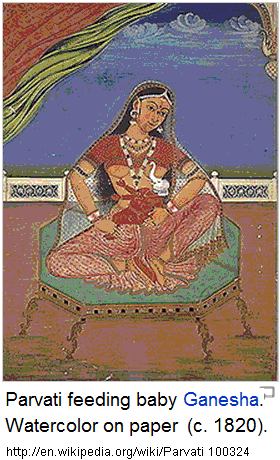 Etymology
Etymology Parvata is one of the Sanskrit words for "mountain"; "Parvati" translates to "She of the mountains" and refers to Parvati being born the daughter of Himavan, lord of the mountains and the personification of the Himalayas. Other names which associate her with mountains are Shailaja (Daughter of the mountains), Girirajaputri (Daughter of king of the mountains). [1]
She is also known by 108 names as per Durga Saptashati, that includes Ambika (mother), Gauri (golden, fair),[2] Shyama (dark complexioned), Bhairavi (awesome), Kali (black-colored), Umā,[3] Lalita, Aparna, the maternal epithet Mataji, Durga, the Goddess Beyond reach, the one who killed Demon Durgam, Bhavani, The Goddess of Universe and many hundreds of others; the Lalita sahasranama contains an authoritative listing. The name Uma is used for Sati in earlier texts, but in Ramayana is used as synonym for Parvati. In Harivamsa, Parvati is referred to as Aparna (One who took no sustenance) and then addressed as Uma, who was dissuaded by her mother from severe penance by saying u mā (oh don't).[4] But Lalita Sharanshram describes 1008 names of the Goddess.
The apparent contradiction that Parvati is addressed as the fair one, Gauri as well as the dark one Kali or Shyama can be explained by the following Hindu myth: when Shiva rebuked Parvati about her dark skin colour, the angry Parvati left him and underwent severe penance to get a fair colour as a boon from Brahma. [5]
In Hinduism there are three sects
Shaivism in
regard to Lord Shiva, Vaishnavism
in regard to Lord Vishnu or Lord Krishn,
Shaktas in regard to Goddess Shakti or Goddess Parvati. "Daughter of the
Mountain," Parvati Devi is the primary personification of Shakti Herself and
regarded as principle Diety of the Sect. Her consort is Shiva; Her children
famously include Lord Ganesh and Skanda, but in fact She is the Mother of all
Gods and Goddesses, of all humanity and Creation itself. Being Shakti's "base
form," Parvati manifests Her wrath as, for example, Durga and Kali; and Her
benevolence as, for example, Lakshmi and Saraswati. She is every other Goddess,
as well. When we worship any Goddess, or even any God for that matter, we are
ultimately worshiping Her. She is sagun swaroop of Adi
Parashakti that's why it is frequently said Adi Shakti swaroopa Devi Maa
Parvati.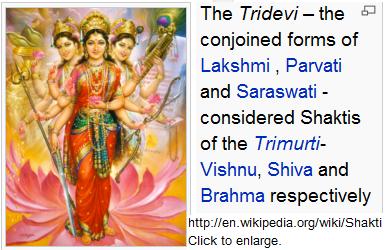
Excerpt from: Wikipedia http://en.wikipedia.org/wiki/Shakti 081012
[UKT: See my work on the Folk Elements in Burmese Buddhism by Dr. Htin Aung in http://www.tuninst.net/Myanmar/Folk-elements/indx-folk.htm 081012].
Shakti, meaning sacred force, power, or energy, is the Hindu concept or personification of the divine feminine aspect, sometimes referred to as 'The Divine Mother'. Shakti represents the active, dynamic principles of feminine power. In Shaktism, Shakti is worshiped as the Supreme Being. However, in other Hindu traditions of Shaivism and Vaishnavism, Shakti embodies the active feminine energy Prakriti of Purusha, who is Vishnu in Vaishnavism or Shiva in Shaivism. Vishnu's female counterpart is called Lakshmi, with Parvati being the female half of Shiva.
Parvati is Shakti's (i.e. the Divine Feminine's) second incarnation as wife to Shiva. After Shiva's first wife, Sati, died, Her divine body parts were strewn all over India (all the places where parts landed became Shakti pithas, or "seats of the Goddess," which are now sites of Devi temples) -- and Shiva completely turned His back on the world, resuming the life of an ascetic in a remote Himalayan cave, while the demon Taraka overran the heavens and earth below.
With no "living" Shakti (manifest Divinity) to balance Shiva (transcendent Divinity), the Cosmic order was thrown into disarray: Shiva had no interest in the world, and in any event was "powerless" (Sanskrit Shakti = Power, Energy) to help it. And so the gods prayed to Shakti to incarnate once again and turn Shiva back to the world, thereby restoring Cosmic balance and saving the world. Shakti agreed, and thereupon took birth as Parvati, Daughter of Himavan, Lord of the Mountains.
Of course, She grew up to be a stunningly beautiful, charming and alluring woman — Her "mission," after all, was to lure Shiva out of His asceticism, and take Him as Her consort. And so every day, She would visit Shiva's cave, sweep the floor, decorate it with flowers and offer him fruits and other gifts of the earth, hoping to win His love.
Shiva, however, never even opened His eyes to notice Her. So Parvati enlisted the aid of Priti and Rati, the goddesses of Love and Longing, who transformed Shiva's cave into a sensuous pleasure garden, filled with fragrant flowers, exotic birdsongs and buzzing honeybees. With the stage thus set, Kama, the beautiful God of Love, appeared and shot Shiva with the arrows of desire. But Shiva, unamused, simply opened the third eye on His forehead and blasted Kama with an energy beam that incinerated him on the spot: And so Love was lost from the world.
"Do not despair," Parvati told the gods, when this happened. "Shiva will become My consort. And when He does, Kama will be reborn."[6]
Parvati does not appear in Vedic literature. The Kena Upanishad (3.12) contains a goddess called Uma-Haimavati.[7] She appears as the shakti, or essential power, of the Supreme Brahman. Her primary role is of a mediator who reveals the knowledge of Brahman to the Vedic trinity of Agni, Vayu, and Indra boasting and posturing in the flush of a recent victory over a demon hoard.[8] But Kinsley notes: "it is little more than conjecture to identify her with the later goddess Satī-Pārvatī, although [..] later text that extol Śiva and Pārvatī retell the episode in such a way to leave no doubt that it was Śiva's spouse.."[7] Both textual and archaeological evidence suggests Sati-Parvati appears in epic period (400 BC–400 AD). Both the Ramayana and the Mahabharata present Parvati as Shiva's wife.[7] It is not until the plays of Kalidasa (5th-6th centuries) and the Puranas (4th through the 13th centuries) that the myths of Sati-Parvati and Shiva acquire comprehensive details.[9] Kinsley adds that Parvati may have emerged from legends of non-aryan goddesses that lived in mountains.[1]
Prof. Weber suggests that like Shiva is combination of various Vedic gods Rudra and Agni, the Puranic Parvati is a combination of Uma, Haimavati, Ambika and earlier Parvati, identified as wives of Rudra; of others like Kali, who could be a wife of Agni and of Gauri and others inspired by Nirriti, the goddess of evil.[10] Tate suggests Parvati is a mixture of the Vedic goddess Aditi and Nirriti, and being a mountain goddess herself, was associated with other mountain goddesses like Durga and Kali in later traditions.[11]
 The
Puranas repeatedly tell the tale of Sati's marriage to Shiva against her father
Daksha's wishes
and her subsequent self-immolation at Daksha's
Yajna (fire
offering) leaving Shiva grief-stricken and having lost interest in worldly
affairs. In
Brahma Vaivarta Purana, Sati appears before Shiva, in her divine form, and
reassures him that she will return as the daughter of Himavan.[12]
Sati is reborn as Parvati, the daughter of Himavan, and the
apsara
Menā and is
named "Kali", the dark one as per her complexion.[13]
Sati as well as Parvati are considered manifestations of
Mahadevi,
the "great Goddess".[13]
In Ramayana, the river
Ganga is depicted as the elder sister of Parvati; while in Harivamsa Parvati
has two younger sisters called Ekaparna and Ekapatala.[4]
The
Puranas repeatedly tell the tale of Sati's marriage to Shiva against her father
Daksha's wishes
and her subsequent self-immolation at Daksha's
Yajna (fire
offering) leaving Shiva grief-stricken and having lost interest in worldly
affairs. In
Brahma Vaivarta Purana, Sati appears before Shiva, in her divine form, and
reassures him that she will return as the daughter of Himavan.[12]
Sati is reborn as Parvati, the daughter of Himavan, and the
apsara
Menā and is
named "Kali", the dark one as per her complexion.[13]
Sati as well as Parvati are considered manifestations of
Mahadevi,
the "great Goddess".[13]
In Ramayana, the river
Ganga is depicted as the elder sister of Parvati; while in Harivamsa Parvati
has two younger sisters called Ekaparna and Ekapatala.[4]
Parvati is depicted as interested in Shiva's tales and appearance from her very birth and finally remembering her last life as Sati.[13] As Parvati grew into a young woman, she began tapas (austerities) to please Shiva to grant her wish to reunite with him. She is portrayed as surpassing all other ascetics in penance, undergoing mortifications. Finally, Shiva tests her devotion by sending an attendant or appearing himself in disguise to criticize Shiva. Untouched by the act, Parvati retains her desire for Shiva compelling him to marry her. After the marriage, Parvati moves to mount Kailash, the residence of Shiva.[14]
Kalidasa's epic Kumarasambhavam ("Birth of Kumara") details with matchlessly lyrical beauty the story of the maiden Parvati; her devotions aimed at gaining the favour of Shiva; the subsequent annihilation of Kamadeva; the consequent fall of the universe into barren lifelessness; the subsequent nuptials, in these circumstances, of the partners of many previous births; the immaculate birth of Skanda (Kumara, Shiva's first son) and the eventual resurrection of Kamadeva after intercession by Parvati to Shiva in his favour.
The depiction of Parvati’s marriage to Shiva, in the Shiva Purana, could be seen as an allegory illustrating the desire of an individual to achieve a state of liberation from strife and banality. If one sets aside, for the moment, the idea of Shiva as a male entity, and sees him instead as representing a state beyond human suffering, then Parvati becomes symbolic of the aspirant who wishes to achieve nirvana, and the story becomes something considerably more than a quaint romantic tale. The acharyas (scholastic saints), who wrote the Puranas, may have interpreted Parvati’s asceticism as a means of winning Shiva’s hand in marriage, in order to discourage young girls from following the goddess’s example, and becoming renunciates. In modern day Hinduism the marriage aspect of this story has been inflated in importance, but the most compelling picture we are left with, is Parvati as an ascetic.[15]
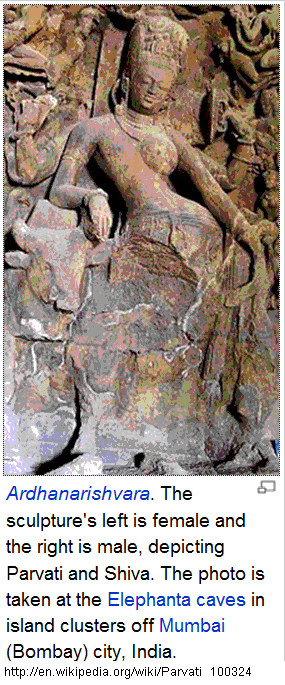 Parvati's
legends are intrinsically related to Shiva. It is only in goddess-oriented
Shakta texts, she is said to transcend even Shiva, identifying her as the
Supreme Being.[1]
Just as Shiva is at once the presiding deity of destruction and regeneration,
the couple jointly symbolise at once both the power of renunciation and
asceticism and the blessings of marital felicity.
Parvati's
legends are intrinsically related to Shiva. It is only in goddess-oriented
Shakta texts, she is said to transcend even Shiva, identifying her as the
Supreme Being.[1]
Just as Shiva is at once the presiding deity of destruction and regeneration,
the couple jointly symbolise at once both the power of renunciation and
asceticism and the blessings of marital felicity.
Parvati thus symbolises many different virtues esteemed by Hindu tradition: fertility, marital felicity, devotion to the spouse, asceticism, and power. It is said in the Saundaryalahari[citation needed], a famous literary work on the goddess, that she is the source of all power in this universe and that because of her, Lord Shiva gets all his powers.
Parvati represents the householder ideal in the perennial tension in Hinduism in the household ideal and the ascetic ideal, represented by Shiva.[16] In classical Hindu mythology, the "raison d’être" of Parvati, and before that of Sati, is to lure Shiva into marriage and thus into a wider circle of worldly affairs.[17] Parvati civilizes Shiva, the "great unpredictable madman" with her presence.[16] When Shiva does his violent, destructive tandava dance, Parvati is described as calming him or complementing his violence by slow, creative steps of her own Lasya dance.[18] In many myths, Parvati is not as much his complement as his rival, tricking, seducing, or luring him away from his ascetic practices.[18] Again, Parvati subdues Shiva's immense sexual vitality. In this context, Shiva Purana says: 'The linga of Shiva, cursed by the sages, fell on the earth and burnt everything before it like fire. Parvati took the form of a yoni and calmed it by holding the linga in her yoni'. The Padma Purana also tells the story of Parvati assuming the form of yoni to receive lingam of Shiva, who was cursed by sage Bhrigu to be the form of the lingam.[19]
Three images are central to the mythology, iconography and philosophy of Parvati:
1. The theme of Shiva-Shakti
2. The image of Shiva as Ardhanarishvara (the Lord who is half-woman)
3. The image of the linga and the yoni
These images that combine the two deities, Shiva and Parvati, yield a vision of reconciliation, interdependence and harmony between the way of the ascetic and that of a householder.[20]
The couple are often depicted in the Puranas as engaged in "dalliance" or seated on Mount Kailash or discussing abstract concepts in Hindu theology. Occasionally, they are depicted as quarrelling.[5] In stories of the birth of Karikkeya, the couple are described as love-making generating the seed of Shiva. Parvati's union with Shiva symbolises the union of a male and female in "ecstasy and sexual bliss".[21] In art, Parvati is depicted seated on Shiva's knee or standing beside him (together the couple is referred to as Uma-Maheshvara or Hara-Gauri) or as Annapurna (the goddess of grain) giving alms to Shiva.[22]
Shaiva approaches tend to look upon Parvati primarily as the Shiva's submissive and obedient wife and helpmate. However, Shaktas focus on Parvati's equality or even superiority to her consort. The story of the birth of the ten Mahavidyas (Wisdom Goddesses) of Shakta Tantrism. This event occurs while Shiva is living with Parvati in her father's house. Following an argument, he attempts to walk out on her. Her rage manifests in the form of ten terrifying goddesses who block Shiva's every exit.
As the scholar David Kinsley explains, "The fact that [Parvati] is able to physically restrain Shiva dramatically makes the point that she is superior in power. The theme of the superiority of the goddess over male deities is common in Shakta texts, [and] so the story is stressing a central Shakta theological principle. ... The fact that Shiva and Parvati are living in her father's house in itself makes this point, as it is traditional in many parts of India for the wife to leave her father's home upon marriage and become a part of her husband's lineage and live in his home among his relatives. That Shiva dwells in Parvati's house thus implies Her priority in their relationship. Her priority is also demonstrated in her ability, through the Mahavidyas, to thwart Shiva's will and assert her own."[23]
Though Ganesha considered as son of Shiva and Parvati, the Matsya Purana, Shiva Purana, and Skanda Purana ascribe the birth of Ganesha to Parvati only, without any form of participation of Shiva in Ganesha's birth.[24]
Once, while Parvati wanted to take a bath, there were no attendants around to guard her and stop anyone from accidentally entering the house. Hence she created an image of a boy out of turmeric paste which she prepared to cleanse her body, and infused life into it, and thus Ganesha was born. Parvati ordered Ganesha not to allow anyone to enter the house, and Ganesha obediently followed his mother's orders. After a while Shiva returned and tried to enter the house, Ganesha stopped him. Shiva was infuriated and severed Ganesha's head with his trishula (trident). When Parvati came out and saw her son's lifeless body, she was very angry and sad. She demanded that Shiva restore Ganesha's life at once. Unfortunately, Shiva's trishula was so powerful that it had hurled Ganesha's head so far off that it could not be found. Finally, an elephant's head was attached to Ganesha's body, bringing him back to life. Still upset, Parvati demanded her son be made head of the celestial armies and worshipped by everyone before beginning any activity, and gods accepted this condition.
Ganesha is identified as a god named after his mother. He is called Umaputra, Parvatisuta, Gaurisuta meaning son of Parvati and Heramba, "mother's beloved (son)".[25
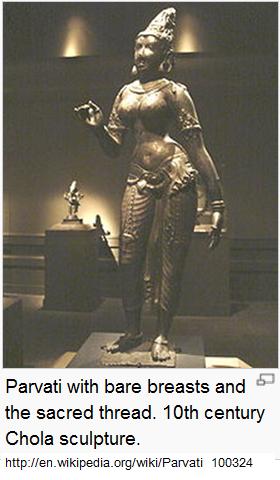 Naturally,
Parvati’s unique characteristics have become more and more obscured, as she
absorbed more and more goddesses into her iconography. Therefore, her depictions
have become rather generic today. When shown with Shiva, she carries a blue
lotus in full bloom, shows the abhaya
mudra (hand
gesture of fearlessness) and usually has one of her children on her knee. The
only hint of her former occult status is the somewhat languid appearance of her
eyes, as one who has recently emerged from deep meditation. Other goddesses are
usually shown with large staring eyes as this is considered a mark of beauty.
The consorts of the other two Gods of the trinity, Saraswati and Lakshmi, may be
depicted alone, and enjoy large followings of their own, apart from Brahma and
Vishnu, but Parvati hasn’t been depicted this way for many centuries. Still, for
the dogged researcher, depictions are there which give hints as to the original
appearance of Goddess Parvati even if they are a bit clouded. But the forms of
Parvati, which points Durga and Kali, who have largest following including Lord
Shiva and Lord Vishnu also.[citation
needed]
Naturally,
Parvati’s unique characteristics have become more and more obscured, as she
absorbed more and more goddesses into her iconography. Therefore, her depictions
have become rather generic today. When shown with Shiva, she carries a blue
lotus in full bloom, shows the abhaya
mudra (hand
gesture of fearlessness) and usually has one of her children on her knee. The
only hint of her former occult status is the somewhat languid appearance of her
eyes, as one who has recently emerged from deep meditation. Other goddesses are
usually shown with large staring eyes as this is considered a mark of beauty.
The consorts of the other two Gods of the trinity, Saraswati and Lakshmi, may be
depicted alone, and enjoy large followings of their own, apart from Brahma and
Vishnu, but Parvati hasn’t been depicted this way for many centuries. Still, for
the dogged researcher, depictions are there which give hints as to the original
appearance of Goddess Parvati even if they are a bit clouded. But the forms of
Parvati, which points Durga and Kali, who have largest following including Lord
Shiva and Lord Vishnu also.[citation
needed]
The goddess is usually represented as a fair and beautiful.[26] The colour of her vestments is milk-white, the colour of enlightenment and knowledge. Since white is a combination of all hues it shows that She has all the qualities or Gunas. Since white also depicts huelesness, it indicates that She is devoid of all Gunas. Hence, She is referred to as Trigunatmika (having the three gunas — Sattva, Rajas, and Tamas — and at the same time being Nirguna (without any gunas). She has three eyes. Her accoutrements tend to be those of a Rishi (seer) but she may also wear the ceremonial garments and carry the ritual items of a Gur (Himalayan Oracle).[citation needed] She is also usually depicted with jatamukuta or a crown of matted hair, as Shiva is usually depicted. She is also shown as having a cresent moon bound in her locks, like Shiva.
Parvati is consistently depicted with bare breasts and wearing a sacred thread in Pallava, Chola, and Jain statuary, right up until the Muslim invasion in 12th century AD. Bare breasts were considered a mark of divinity in ancient India and only those Goddesses who were exclusively divine may go about "skyclad", as it were. Clothes symbolised the body and earthly attachments whereas nudity was indicative of unfettered divinity.[27] According to the Iconographic Dictionary of the Indian Religions by Gosta Leibert, She carries a rosary, mirror, bell, and citron in her four hands.[28]
Images of Parvati, wearing a sacred thread something not many women are associated with and as this marks the second-birth or dwija it is seems an advanced concept far beyond early pashupatas, and with her hair styled in a top knot like a Rishi (seer) survive into the Chola period (approximately ninth century A.D.). In fact, these two particularities were the only means of distinguishing her statuary from the images of the Goddess Shri of the time.[citation needed]
Her Mudras (symbolic hand gestures) are Kataka — fascination and enchantment, Hirana — the antelope, the powers of nature and the elusive, Tarjani —gesture of menace, and Chandrakal — the moon, a symbol of intelligence. Kataka must be affected by one of the foremost hands as it is a means of drawing the worshiper closer. Tarjani must be described with the left hand, which symbolises contempt, and usually in the back set of hands. If Parvati is depicted with two hands, then Tarjani and Chandrakal may be dropped but Hirana and Kataka are signature except in very modern representations, where Abhaya (fearlessness), and Varada, (beneficence), are used. Abhaya and Varada are depicted almost as a matter of course in modern depictions as they are “safe” mudras and are unlikely to carry any inauspicious side effects for the artist if he is superstitious. Therefore these two mudras are a common resort when the artist is in doubt about the specifications of a particular deity; however they are not special to Parvati more than any other deity.[citation needed]
Parvati’s Vahana (animal vehicle), is usually considered to be a lion nowadays, in her form of Durga’s, but was probably originally one of the mountain lions native to the Himalayas. It was also, likely, a lioness, as Parvati’s cult is so exclusively feminine.[29] Although there is no documentation to support an affiliation between Goddess Parvati and this wondrous, mythic animal, it does seem an appropriate vehicle for an ascetic magical mountain goddess with an exclusively female clergy and following.[30][citation needed].In certain aspects of Parvati, such as the Mahagouri form of the Navadurga group, her vahana is Shiva's vahana, Nandi, the sacred bull.
In several myths, the presence of a dark, violent side of this otherwise benign Parvati is suggested. When approached by the gods to defeat demons, Parvati typiclly gets angry at the prospect of war and from her wrath emerges a violent goddess, which proceeds to fight on Parvati's behalf. This goddess is usually identified as the terrible, black aspect of the goddess, Kali.[16] In Linga Purana, Parvati summons Kali on the request of Shiva, to destroy a female asura (demoness) Daruka. The legend further concludes with Kali breast-feeding Shiva, who appeared on the battlefield as an infant.[31] Kali is associated and identified with Parvati as Shiva's consort.[32]
In Skanda Purana, Parvati is said to have assumed a form of a warrior-goddess and defeated a demon called Durg who assumes the form of a buffalo. Thereafter, she is by the name Durga.[33] In myths relating to her defeat of demons Sumbha and Nisumbha, Durga emerges from Parvati when Parvati sheds her outer sheath, which takes an identity of its own as a warrior goddess.[33]
Although Parvati is considered to be synonymous with Kali, Durga, Kamakshi, Meenakshi, Gauri and many others in modern day Hinduism, many of these “forms” or incarnations originated from different sects, or traditions, and the distinctions from Parvati are pertinent.[34]
The Shastras (sanctioned works of religious doctrine) attribute the golden colour of goddess Gauri’s skin and ornaments to the story of Parvati casting off her unwanted dark complexion after Shiva teased her, but the cult of Gauri tells a different story. Gauri is in essence a fertility Goddess, and is venerated as a corn mother which would seem to suggest that she owes her colouring to the hues of ripening grain, for which she is propitiated.[35]
Parvati’s worship originated in the Himalayas. Her qualities were not so much warlike, or deathly, (as Kali’s and Durga’s,) but rather supernatural. She was venerated as the Queen of the Pariyan - small, winged, female woodland beings.[citation needed] Men were, and are, forbidden in the inner sanctum of many of her temples.
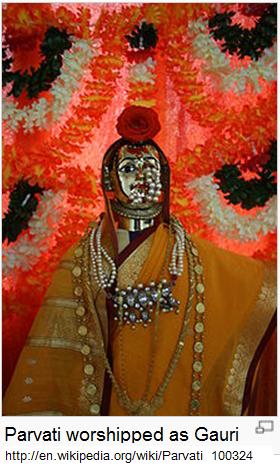 The
Gauri Festival is celebrated on the seventh, eighth, ninth of
Bhadrapada
Shukla. She is worshipped as the goddess of harvest and protectress of
women. Her festival, chiefly observed by women, is closely associated with the
festival of her son Ganesha (Ganesh
Chaturthi). The festival is popular in
Maharashtra and
Karnataka.[36]
The
Gauri Festival is celebrated on the seventh, eighth, ninth of
Bhadrapada
Shukla. She is worshipped as the goddess of harvest and protectress of
women. Her festival, chiefly observed by women, is closely associated with the
festival of her son Ganesha (Ganesh
Chaturthi). The festival is popular in
Maharashtra and
Karnataka.[36]
In Rajasthan the worship of Gauri happens during the Gangaur festival. The festival starts on the first day of Chaitra the day after Holi and continues for 18 days. Images of Issar and Gauri are made from Clay for the festival.
Another very popular festival in regard to the Mother Parvati is Navratri, in which all her manfestations are worshiped for nine days. Actually the festival is associated with Her warrior appearance is Mother Durga, with her nine forms i.e. Shailputri, Brahmacharini, Chandraghanta, Kashmunda, Skandmata, Katyani, Kalratri, Mahagauri, Siddhidaatri.
Another festival Gauri tritiya is celebrated from Chaitra shukla third to Vaishakha shukla third. It is believed that Parvati spends a month at her parent's home now. This festival is popular in Maharashtra and Karnataka, less observed in North India and unknown in Bengal. The unwidowed women of the household erect a series of platforms in a pyramidal shape with the image of the goddess at the top and collection of ornaments, images of other Hindu deities, pictures, shells etc. below. Neighbours are invited and presented with turmeric, fruits, flowers etc. as gifts. At night, prayers are held by singing and dancing.[37]
Some of the famous temples where Parvati forms are predominantly worshipped include,
• Shakti Peethas
• Meenakshi temple at Madurai in Tamilnadu, India
• Kamakshi Amman temple at Kanchipuram in Tamilnadu, India
• Akilandeswari temple at Thiruvanaikaval in Tamilnadu, India
• Visalakshi temple at Banaras, Uttar Pradesh, India
• Ambaji temple at Ambaji, Gujarat, India
UKT: End of Wikipedia article.
Go back Parvati-note-b
End of TIL file